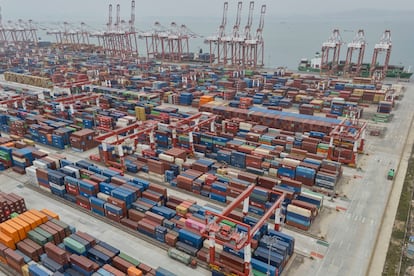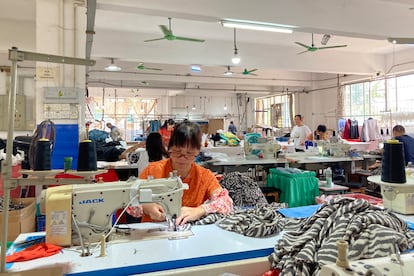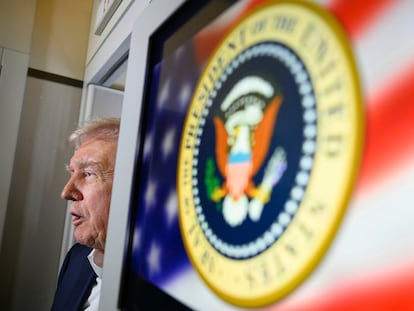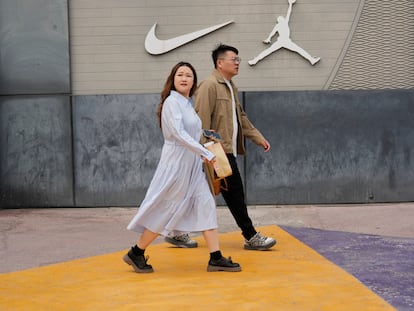Guangzhou feels the pain of the trade war but challenges Trump: ‘China will win’
The capital of Guangdong province in the south of the country is a major manufacturing center; many of its factories have suspended shipments to the US


If the tariff war is a war, then the Chinese city of Guangzhou is one of its main fronts. The capital of Guangdong province — one of China’s major production centers, located in the south of the country — can be viewed as a commercial and manufacturing center with an export focus. In districts like Panyu, where hangars, warehouses and factories of all kinds line up one after the other, Donald Trump’s barrage of tariffs has been felt, and the report from the battlefield is worrying, but not catastrophic: “The tariff war is ultimately going to hurt everyone; people like me, who just want to make a living,” says Lily Liao, owner of Guangzhou Dawang Garment, a textile factory covering 140,000 square feet. Her orders from U.S. businesses amounted to about $100,000 a month before Trump took office. Almost three months later, they have fallen to zero.
Their situation is similar to that of eight other Chinese factories in the city whose managers spoke with EL PAÍS last week. All of them report having been forced to suspend all or almost all shipments. Clients have requested time until the situation gets cleared up; others have remained silent or canceled contracts; factory managers also mention returned containers and shipments held back in warehouses. The factories have not stopped operating, because production destined for the United States represents only a fraction of their exports. But they do admit to readjusting processes.
“U.S. policies change every day, customers are sitting back and watching,” says Mr. Wang, founder of Guangshen, a Panyu-based maker of ice cream and smoothie machines. This is the first time in his 21 years in the business that he has stopped all shipments to the United States. The country accounts for between 10% and 15% of his sales; the figure is similar to that of China as a whole, which has been reducing exports to the U.S. to the current 14%. “It’s impossible for two countries to stop doing business forever,” he says. But, just in case, he is looking for ways to fill the gap: this week he planned to show one of his factories to customers in Algeria and Brazil.

Some compare the situation to the impact of the Covid pandemic. Suddenly, one of the most intense trade flows on the planet has come to a virtual standstill. According to data from the logistics company Vizion, freight rates from China to the United States fell 64% between the last week of March and the first week of April, when Trump celebrated “Liberation Day.” Global freight rates plummeted 49%.
For the textile entrepreneur Lily Liao, the blow wasn’t immediate. She recounts a succession of scrapes dating back to Trump’s first term in office. Of Taiwanese origin, Liao settled in Guangzhou in the early 2000s. These were the years when China had just joined the World Trade Organization (2001) and the currents of globalization were connecting the planet. She did well for herself. “More and more clients wanted to work with China.” She supplied clothing to top-tier U.S. brands like GAP and Banana Republic. She reached an annual turnover of up to $4.8 million in orders to the United States. When Trump unleashed his first tariff fury in 2018, she had to reduce her business with that country by 70%, she says.
The second set of tariffs has closed her channels to the U.S. After the first 10% tariff increase in February, her clients asked for a price cut. She agreed, but the trade battle escalated. Beijing responded, Washington raised rates again, and the crossfire has driven up U.S. tariffs to a stratospheric 145%, and Chinese tariffs to 125%. “It’s too much,” Liao says. “I can’t lower prices that much.”
Since last year, she estimates she has lost 25% of turnover. She attributes this to both tariffs and weakening global trade; China is also experiencing a period of sluggish consumption, although it surprised the world with 5.4% GDP growth in the first quarter, above expectations, and a 6.9% increase in exports, which analysts say is due to importers placing orders early in anticipation of the imminent entry into force of the new tariffs.
Liao’s factory specializes in women’s designs. She leads the way to the workshops, where the whir of sewing machines can be heard, and the employees — mostly women — move the fabric to the sound of needles. The factory currently employs around 60 permanent workers. Many live in the factory quarters. They earn between 4,000 and 10,000 yuan a month (between $548 and $1370), “depending on their performance.”
Two other young workers at another factory reported daily wages of 300 yuan ($41), with 13-hour workdays and two days off per month: this is also the Chinese model. The region remains a magnet for thousands of internal migrants in search of jobs.
“These are for South Korea,” Liao shows off some ivory T-shirts. “These are for the U.K.,” she points to others with zebra prints. Talking to her leaves one with a certain sense of the end of an era of globalization. Liao replies, taking a pen and tracing a wave graph on paper: “There is no end, only ups and downs,” she explains. “Now Trump’s policies are affecting the world, and we’re at a low point. But he’s over 70 years old, and there are elections every four years. This situation won’t last forever.”
In Panyu, workshops like hers abound. There are more than 7,200 garment-making companies in the district and another 27,000 selling garments, according to official data. Many are concentrated in Nancun, an area known as “Shein Village” due to the number of companies that supply the Chinese fast-fashion giant and other similar platforms, such as Temu. Shein Village is a labyrinth of narrow streets, where street-level workshops and transport motorcycles carry rolls of fabric and sacks of clothes back and forth. The four- or five-story floors are occupied by textile factories. Their walls are plastered with advertisements seeking employees, specifying salaries, reclaiming fabric, or offering debt collection services.

Trump’s tariff war has also hit the business model of these new platforms, which offer ultra-fast fashion at ridiculously low prices and with near-instant shipping to every corner of the globe. Packages entered the United States through a loophole that allowed small shipments valued at up to $800 without paying taxes or duties. This so-called de minimis exception resulted in a huge influx. Customs duties will apply to them starting May 2.
At a family-run shop specializing in button sewing, managers report a 20% drop in orders; at another, dedicated to elastic pleats, they report a 50% drop in orders since last year. At dusk, in a street-side shop, a man irons and four women pack garments into Shein bags. Soon they will take a few minutes to eat a bowl of rice before resuming their work. The owner, Luo Weijun, a migrant from Jiangxi province, also toiled in workshops before founding his own company. As he speaks, he helps out by packing clothes into sacks. He doesn’t know the fate of his products. For now, he’s noticed a 5% drop in orders. “The tariffs seem like child’s play to me,” he says. He believes they won’t have much of an impact in the end: “We have a better industry. The United States doesn’t have factories. And we can always sell our production within China.”
In the province of Canton alone, with a population of 126 million, there are almost 74,000 industrial companies with a turnover of more than 20 million yuan ($2.7 million). The region was one of the places where Deng Xiaoping tested the reforms of the 1980s that cemented the years of hyper-economic growth. In the capital, Guangzhou, China’s first five-star hotel, the White Swan, opened in 1983; it was also the country’s first skyscraper. Richard Nixon, Helmut Kohl, George Bush Sr., and Queen Elizabeth II have all stayed there.
“China is going to win”
Guangzhou also hosts one of China’s most famous trade events, the Canton Import and Export Fair. The conclave kicked off last week, with more than 3,000 companies and some 200,000 registered foreign buyers. It’s a good place to take the temperature of the trade war. “China is going to win,” smiles Tracy, a Chinese woman in Sector A of the gigantic fairgrounds. Her company, Aiken, sells waffle makers and toasters, primarily to Europe. Her only American client called last week to request a six- to eight-week break. She doesn’t seem worried.
Faces and languages mingle in endless aisles of displays featuring vacuum cleaners, fans, air conditioners, refrigerators, dryers, washing machines, coffee makers, switches, cables, lamps, fuses, electric motorcycles, cars... Prices are inquired about, deals are made. Many Russians are there African women carry bags with a huge silkscreen print: Made in China.
A pair of German visitors who import household appliances and declined to give their names expressed concern about the potential flood of Chinese products into the EU market. “Europe must stay united,” said one.
Spanish is also heard, with multiple accents. “Any company that can’t bring its production to the United States will shift it to another market,” notes Pedro López, an Argentine man who represents Chinese factories in Latin America. He predicts intense competition and downward pressure on prices. Many Chinese companies, he says, had already prepared for a trade war, opening factories in Mexico, Thailand and Vietnam.
Alejandro Jiménez, a Colombian who lives in Miami, radiates deep anger at Trump’s policies. His company, which imports packaging products, used to ship five containers a month from China to the United States. On the misnamed Liberation Day, several of them were out at sea, even as the price was rising almost every day. “Inflation is going to rise,” he predicts. At the fair, the first thing he does is ask Chinese companies if they have factories in other countries. “I’m looking for other sourcing options,” he explains to the Longhua exhibitor, which produces plastic cable ties.
Longhua is a giant in its field. It has more than 500 employees and has suffered a considerable blow: the United States represents nearly 43% of its sales, more than $39 million. When tariffs surpassed 80% last week, almost all of its customers in that country asked for a pause in shipments, explains Jianguo Qu, one of the managers. “If tariffs continue to rise, we will have no choice but to sell to other countries,” he adds. The company advertises with a prominent sign that it has a factory in Thailand about to open. And they have already received visits from businesspeople from the United States. Trade doesn’t stop, it’s only changing.
Veterans of this trade fair emphasize, however, that this year there are hardly any American buyers there. This newspaper only found one, Steven Selikoff, 55, an experienced trader and author of a book on product development and manufacturing. “This isn’t the time to panic,” he says. “Trump and Xi [Chinese President Jinping] are smart guys. They’ll find a solution; they need time.” He asserts that this is the best time to visit China. “If you have the courage: crazy times are the times when you can make crazy deals.”
Sign up for our weekly newsletter to get more English-language news coverage from EL PAÍS USA Edition
Tu suscripción se está usando en otro dispositivo
¿Quieres añadir otro usuario a tu suscripción?
Si continúas leyendo en este dispositivo, no se podrá leer en el otro.
FlechaTu suscripción se está usando en otro dispositivo y solo puedes acceder a EL PAÍS desde un dispositivo a la vez.
Si quieres compartir tu cuenta, cambia tu suscripción a la modalidad Premium, así podrás añadir otro usuario. Cada uno accederá con su propia cuenta de email, lo que os permitirá personalizar vuestra experiencia en EL PAÍS.
¿Tienes una suscripción de empresa? Accede aquí para contratar más cuentas.
En el caso de no saber quién está usando tu cuenta, te recomendamos cambiar tu contraseña aquí.
Si decides continuar compartiendo tu cuenta, este mensaje se mostrará en tu dispositivo y en el de la otra persona que está usando tu cuenta de forma indefinida, afectando a tu experiencia de lectura. Puedes consultar aquí los términos y condiciones de la suscripción digital.
More information
Archived In
Últimas noticias
The open war against the oil ‘phantom fleet’
The new language of the workplace: Knowing how to ask AI questions is more important than using it
‘Sleepless City’: The light of cinema illuminates Madrid’s Cañada Real shantytown
Christmas loses its festive spirit: ICE fears cast shadow over religious celebrations
Most viewed
- Families demand repatriation of bodies of Colombians who died in Ukraine: ‘This war is a slaughterhouse for foreigners’
- The low-cost creative revolution: How technology is making art accessible to everyone
- Liset Menéndez de la Prida, neuroscientist: ‘It’s not normal to constantly seek pleasure; it’s important to be bored, to be calm’
- Christian Louboutin: ‘Young people don’t want to be like their parents. And if their parents wear sneakers, they’re going to look for something else’
- ‘El Limones’ and the growing union disguise of Mexican organized crime










































